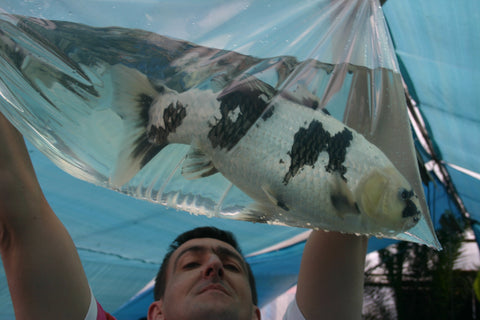Your greatest priority as a Koi keeper should always be the health of the Koi in your pond, whether they are pets or prize winners and regardless of how much you might have paid for them, but once you feel you have provided the best environment for your koi to flourish, you may feel that you wish to learn about the other issues that arise when keeping Koi. One subject that has become more important to Koi keepers in recent years is the sex of the Koi in their pond. But why is it important to know whether your Koi are male or female? For most Koi keepers it isn’t important if their interest is in simply keeping their Koi healthy and having beautiful fish in their pond. The sex of Koi however can affect the quality of the Koi that you buy and the number that you can keep in your pond long term. It is often possible to buy high quality male fish for less than a female fish of the same quality simply because female fish, on average, are likely to grow bigger than male fish. That isn’t to say that male fish always stay small or that female fish always grow big! It just means that the perception that they do is keeping the price of male fish lower than perhaps it really deserves to be – a shrewd koi keeper could use this to their advantage and buy better quality male fish for less money than a female of the same size. The size that Koi grow to is greatly influenced by their environment – water temperature, quality and quantity of food etc and in fact this is likely to play a much bigger part in the future development and growth potential of any koi.
If your interest is in showing your Koi, then once a Koi begins to grow and mature, its sex can influence how big it is likely to grow and determine the way its body shape is likely to develop. At shows in the UK, the sex of the Koi isn’t an issue in itself and there are no categories at the BKKS National Koi Show which recognize the sex of the koi being shown nor have we heard of any at regional shows. However at some Japanese shows categories just for male fish have been introduced which recognize the outstanding qualities that they can display and which would otherwise be overshadowed by their generally bigger female counterparts. At the All Japan Combined Nishikigoi Show there are two divisions, the general division which has 19 variety classes and a male division, for koi over 50 cm, which has seven variety classes. The fact that the male division starts at 50 cm demonstrates that sexing koi below this size is often a difficult task and also shows that below this size male koi can do well in competition against their female counterparts. Whilst the top prize of Grand Champion is almost always awarded to a female koi, there are, as always, the odd exceptions – for example at the 31st All Japan Combined Koi Show this top award went to a male Sanke measuring 88 cm. The sex of the Grand Champion at koi shows hasn’t always been recorded as the prize is open to both sexes but there is no doubt that there will have been other male Grand Champions over the years.
The sex of a young Koi does not affect its body shape until it begins to reach sexual maturity, which is usually at around three years of age. It is possible to do well with male fish at smaller sizes in shows but as the fish reach maturity and go above 30 – 40 cm in length, the difference in body shape between the sexes becomes more obvious. It is natural for female fish to develop the appearance of a “fat tummy” when carrying eggs and this can spoil the line of the fish, whereas male fish don’t suffer from this problem. Some females however manage to maintain their gently tapering shape even in the breeding season and it is these that fair better in the show vat. Female Koi generally (but not always) grow larger than male Koi and this is another reason why Koi at bigger sizes in shows tend to be female.
If you aren’t interested in showing Koi, are there any reasons why you should consider single sex ponds? Naturally, Koi will breed in late spring or summer and whilst some Koi keepers find that the fish in their pond have never spawned, other Koi keepers find it happens with annoying regularity every year! The process of spawning produces lots of milt from the male Koi and lots of eggs from the females and the consequence of this is that the water quality in the pond can be adversely affected. This shouldn’t cause any issues however, if managed carefully, and it is advisable to reduce or stop feeding your Koi for a few days after spawning and to ensure that filters are kept clean. Koi will eat any eggs that they can find and also any fry that survive, although usually a few babies find their way into filter systems or plant borders and survive the summer in relative safety. Another possible problem, if spawning takes place, is that the male Koi can be quite vigorous in their attempts to persuade females to release their eggs and if there are any rough edges, pipe work or pumps in the pond, the female can be damaged as she is pushed against them. Spawning can go on for several hours and so if several males are chasing one female it can be exhausting for the female. In extreme circumstances, females can die as a result of frenzied spawning activity although this is very rare and it would be a shame to restrict the sex of Koi in a pond for this reason alone. (If Showing Koi however, you might not want even the slightest risk that your Koi might be damaged before show day!).
Whilst pattern tends not to vary between the sexes, on Go-sanke the hi is often stronger on male fish than on females, particularly when they are younger, making them appear more “finished” at an earlier age than females – another reason why male koi can often do well at shows in the smaller sizes.
It is difficult to tell what gender a koi is until it starts to approach sexual maturity, usually at around three years of age. Even after this time there is always the odd Koi that fails to display any of the normal characteristics of its sex, making sexing koi very difficult for breeder, dealer and hobbyist alike! In mature koi, the most obvious sign is body shape – female fish are usually more rounded and males generally slimmer and more streamlined. Male fish usually feel rough to the touch on their cheeks and sides and can have a slightly yellow tinge to the white skin on the head. There are sometimes other subtle differences in relation to the size and shape of the fins (male fish sometimes have noticeably bigger, less rounded pectoral fins for example) but, to be honest, these can often be imperceptible or misleading. The sex of most mature koi can be determined mostly by body shape and skin texture.
When catching koi in order to examine them it is important to bear in mind that the net should be used only as a means of guiding the koi and should never be used to lift it as this can potentially cause damage to the fish. It is easiest to use a floating basket when examining Koi but a large tub floating in the water and with enough water in it to support the Koi once caught is the next best thing. The edge of the bowl should be dipped under the waiting koi contained in the net, and the koi guided into it.
If your koi feels as smooth on its sides and cheeks as it does on the rest of its body it’s likely to be female but there are the odd exceptions to this rule so if you want to be 100% sure, the next step is to examine the vent on the underside of the fish. There may be a few amongst you with the skills to confidently turn a fish upside down to examine it, without risking bruising the fish in the process, but the method we would recommend is that you place your koi into a plastic bag with a small amount of water and hold it up so that you can look at the underside of the fish. It may be easier to do this with two people – one carrying out the examination and the other holding the bag.
The female vent is slightly protruding or convex and pale pink in colour whilst the male vent is flat or concave – this is the definitive way of sexing a koi.



With young fish it can often be impossible to tell the difference between male and female and if a breeder or dealer is having to quickly sex dozens or hundreds of koi at a time, mistakes can easily be made so it is always worth double checking the sex of a koi before you buy it if it is something that is important to you.
Male koi have a lot to offer and shouldn’t be written off just because of their sex. They could be considered more of a challenge, if you are planning to show your koi and want to go for the bigger size prizes, but it is clearly possible for some males to overcome the odds and outshine their female competition.
This article was written by Mark and Lisa Davis and first appeared in Koi Magazine in 2009








